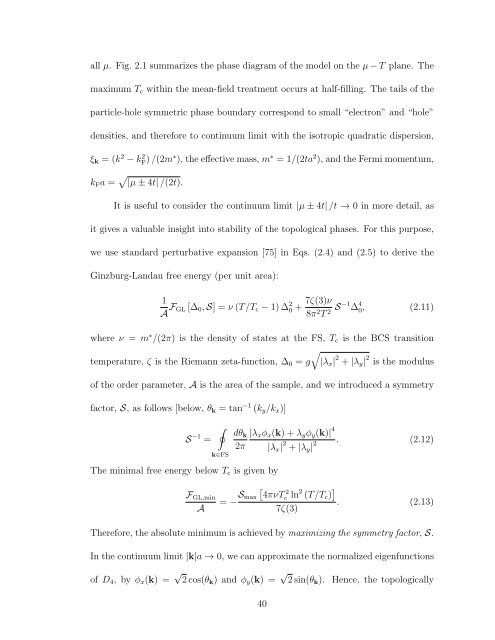ABSTRACT - DRUM - University of Maryland
ABSTRACT - DRUM - University of Maryland
ABSTRACT - DRUM - University of Maryland
You also want an ePaper? Increase the reach of your titles
YUMPU automatically turns print PDFs into web optimized ePapers that Google loves.
all µ. Fig. 2.1 summarizes the phase diagram <strong>of</strong> the model on the µ − T plane. The<br />
maximum T c within the mean-field treatment occurs at half-filling. The tails <strong>of</strong> the<br />
particle-hole symmetric phase boundary correspond to small “electron” and “hole”<br />
densities, and therefore to continuum limit with the isotropic quadratic dispersion,<br />
ξ k = (k 2 − k 2 F ) /(2m∗ ), the effective mass, m ∗ = 1/(2ta 2 ), and the Fermi momentum,<br />
k F a = √ |µ ± 4t| /(2t).<br />
It is useful to consider the continuum limit |µ ± 4t| /t → 0 in more detail, as<br />
it gives a valuable insight into stability <strong>of</strong> the topological phases. For this purpose,<br />
we use standard perturbative expansion [75] in Eqs. (2.4) and (2.5) to derive the<br />
Ginzburg-Landau free energy (per unit area):<br />
1<br />
A F GL [∆ 0 , S] = ν (T/T c − 1) ∆ 2 0 + 7ζ(3)ν<br />
8π 2 T 2 S−1 ∆ 4 0, (2.11)<br />
where ν = m ∗ /(2π) is the density <strong>of</strong> states at the FS, T c is the BCS transition<br />
√<br />
temperature, ζ is the Riemann zeta-function, ∆ 0 = g |λ x | 2 + |λ y | 2 is the modulus<br />
<strong>of</strong> the order parameter, A is the area <strong>of</strong> the sample, and we introduced a symmetry<br />
factor, S, as follows [below, θ k = tan −1 (k y /k x )]<br />
S −1 =<br />
∮<br />
k∈FS<br />
dθ k<br />
2π<br />
The minimal free energy below T c is given by<br />
F GL,min<br />
A<br />
|λ x φ x (k) + λ y φ y (k)| 4<br />
|λ x | 2 + |λ y | 2 . (2.12)<br />
[ = −S<br />
max 4πνT<br />
2<br />
c ln 2 (T/T c ) ]<br />
. (2.13)<br />
7ζ(3)<br />
Therefore, the absolute minimum is achieved by maximizing the symmetry factor, S.<br />
In the continuum limit |k|a → 0, we can approximate the normalized eigenfunctions<br />
<strong>of</strong> D 4 , by φ x (k) = √ 2 cos(θ k ) and φ y (k) = √ 2 sin(θ k ). Hence, the topologically<br />
40
















